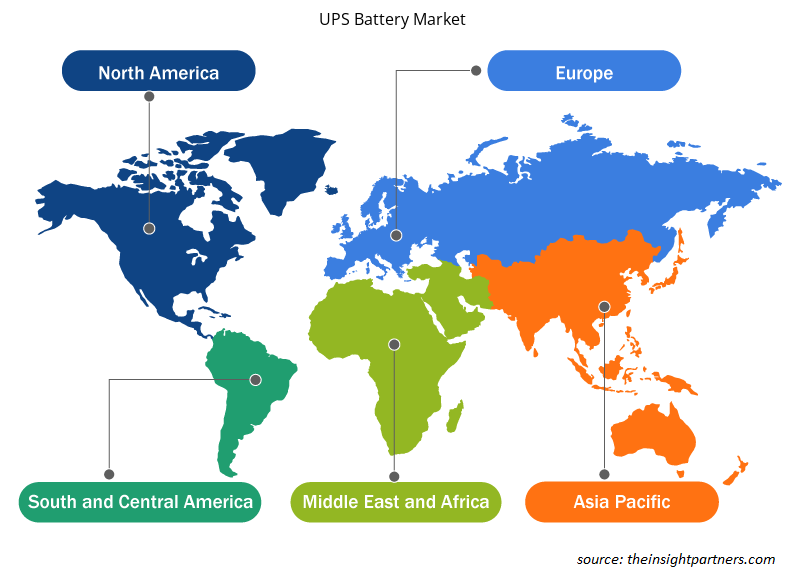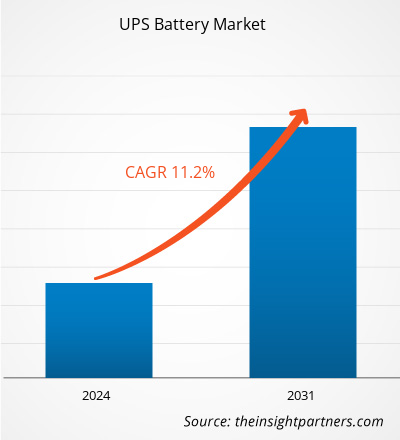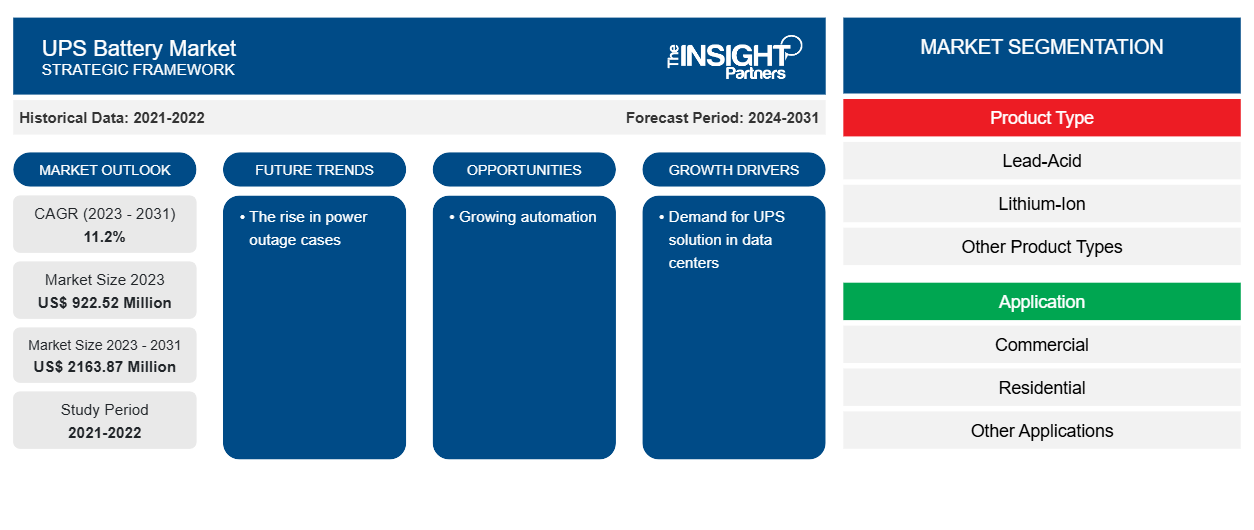من المتوقع أن يصل حجم سوق بطاريات UPS إلى 2163.87 مليون دولار أمريكي بحلول عام 2031 من 922.52 مليون دولار أمريكي في عام 2023. ومن المتوقع أن يسجل السوق معدل نمو سنوي مركب بنسبة 11.2٪ خلال الفترة 2023-2031. ومن المرجح أن يظل ارتفاع حالات انقطاع التيار الكهربائي ونمو القطاع السكني والتجاري من الاتجاهات الرئيسية في السوق.
تحليل سوق بطاريات UPS
إن البناء المتزايد لمراكز البيانات الضخمة في القطاعات التجارية والصناعية يولد الطلب على أنظمة UPS، مما يدفع سوق بطاريات UPS إلى الأمام. إن الحاجة إلى إمداد مستمر بالطاقة للأجهزة الإلكترونية والمرافق والأدوات والبنية الأساسية الحيوية وغيرها من الأشياء تدفع نمو السوق إلى الأمام. إن ارتفاع حالات انقطاع التيار الكهربائي في جميع أنحاء العالم يتطلب حلول UPS، مما يدفع نمو سوق بطاريات UPS إلى الأمام.
نظرة عامة على سوق بطاريات UPS
بطارية مصدر الطاقة غير المنقطعة (UPS) أو مصدر طاقة UPS هو نوع من أنظمة الطاقة التي تعمل كمخزن للطاقة الكهربائية أو احتياطي أثناء انقطاع التيار الكهربائي أو مشكلات انقطاع التيار الكهربائي. تُستخدم عادةً لحماية الأجهزة مثل مراكز البيانات أو أجهزة الكمبيوتر أو معدات الاتصالات أو غيرها من المعدات الكهربائية حيث قد يتسبب انقطاع التيار الكهربائي غير المتوقع في حدوث إصابات أو وفيات أو تعطل الأعمال بشكل خطير أو فقدان البيانات. إن الارتفاع في مراكز البيانات والقطاع الصناعي يدفع نمو سوق بطاريات UPS.
قم بتخصيص هذا التقرير ليناسب متطلباتك
ستحصل على تخصيص لأي تقرير - مجانًا - بما في ذلك أجزاء من هذا التقرير، أو تحليل على مستوى الدولة، وحزمة بيانات Excel، بالإضافة إلى الاستفادة من العروض والخصومات الرائعة للشركات الناشئة والجامعات
-
احصل على أهم اتجاهات السوق الرئيسية لهذا التقرير.ستتضمن هذه العينة المجانية تحليلاً للبيانات، بدءًا من اتجاهات السوق وحتى التقديرات والتوقعات.
محركات وفرص سوق بطاريات UPS
الطلب على حلول UPS في مراكز البيانات
إن حلول UPS هي أنظمة بالغة الأهمية للبنية الأساسية لمراكز البيانات المهمة. إن وجود نظام UPS يوفر طاقة ثابتة وفعالة في مراكز البيانات . وهو يدعم مركز البيانات الكبير عندما ينقطع مصدر الطاقة الأساسي. يحتاج المستخدمون إلى مستويات أعلى من وقت التشغيل. وهذا العامل يولد الحاجة إلى زيادة الطاقة للعمل بكفاءة في مركز البيانات. توفر أنظمة UPS في مركز البيانات كمية دقيقة من الطاقة في غضون مللي ثانية من فقدان الطاقة. وبالتالي، فإن سوق مراكز البيانات المتنامية يعزز نمو سوق بطاريات UPS.
مستخدم نهائي واسع النطاق لبطارية UPS
يشمل المستخدمون النهائيون الرئيسيون لسوق بطاريات UPS القطاعات التجارية والسكنية والصناعية. تعد الأغذية والمشروبات والأدوية ومحطات توليد الطاقة والفضاء الجوي من بين الصناعات المهمة التي تحيط بها احتمالات انقطاع التيار الكهربائي ودرجات الحرارة المحيطة المرتفعة للغاية. نظرًا لحقيقة أن بطاريات UPS هي مكون رئيسي في UPS؛ فهي مسؤولة عن الأداء الجيد ومدة خدمة UPS الطويلة. بالإضافة إلى استخدامها، تعد مراكز البيانات والشركات والأجهزة المنزلية والأدوات الكهربائية تطبيقات أخرى لـ UPS. مع الانتشار المتزايد لـ UPS، سيتم تعزيز نطاق بطاريات UPS.
تقرير تحليل تجزئة سوق بطاريات UPS
إن القطاعات الرئيسية التي ساهمت في اشتقاق تحليل سوق بطاريات UPS هي نوع المنتج والتطبيق.
- وفقًا لنوع المنتج، يتم تقسيم سوق بطاريات UPS إلى بطاريات الرصاص الحمضية وبطاريات الليثيوم أيون وأنواع أخرى من المنتجات. ومن المتوقع أن ينمو قطاع بطاريات الليثيوم أيون بأعلى معدل نمو سنوي مركب.
- من حيث التطبيق، يتم تقسيم السوق إلى تطبيقات تجارية وسكنية وتطبيقات أخرى. وقد استحوذ القطاع التجاري على حصة كبيرة من السوق في عام 2023.
تحليل حصة سوق بطاريات UPS حسب المنطقة الجغرافية
ينقسم النطاق الجغرافي لتقرير سوق بطارية UPS بشكل أساسي إلى خمس مناطق: أمريكا الشمالية، ومنطقة آسيا والمحيط الهادئ، وأوروبا، والشرق الأوسط وأفريقيا، وأمريكا الجنوبية والوسطى.
استحوذت منطقة آسيا والمحيط الهادئ على أكبر حصة من السوق في عام 2023. ويؤدي ارتفاع بناء مراكز البيانات إلى توليد الطلب على الطلب المستمر على إمدادات الطاقة، مما يدفع نمو سوق بطاريات UPS في المنطقة. كما تعمل السلطات الحكومية التي تقدم إعانات وزيادة استثمار اللاعبين في السوق لبناء مراكز البيانات الضخمة على دفع السوق بشكل أكبر. كما أن ارتفاع القطاع السكني يدفع نمو السوق.
رؤى إقليمية حول سوق بطاريات UPS
لقد قام المحللون في Insight Partners بشرح الاتجاهات والعوامل الإقليمية المؤثرة على سوق بطاريات UPS طوال فترة التوقعات بشكل شامل. يناقش هذا القسم أيضًا قطاعات سوق بطاريات UPS والجغرافيا في جميع أنحاء أمريكا الشمالية وأوروبا ومنطقة آسيا والمحيط الهادئ والشرق الأوسط وأفريقيا وأمريكا الجنوبية والوسطى.

- احصل على البيانات الإقليمية المحددة لسوق بطاريات UPS
نطاق تقرير سوق بطاريات UPS
| سمة التقرير | تفاصيل |
|---|---|
| حجم السوق في عام 2023 | 922.52 مليون دولار أمريكي |
| حجم السوق بحلول عام 2031 | 2163.87 مليون دولار أمريكي |
| معدل النمو السنوي المركب العالمي (2023 - 2031) | 11.2% |
| البيانات التاريخية | 2021-2022 |
| فترة التنبؤ | 2024-2031 |
| القطاعات المغطاة |
حسب نوع المنتج
|
| المناطق والدول المغطاة |
أمريكا الشمالية
|
| قادة السوق وملفات تعريف الشركات الرئيسية |
|
كثافة اللاعبين في سوق بطاريات UPS: فهم تأثيرها على ديناميكيات الأعمال
يشهد سوق بطاريات UPS نموًا سريعًا، مدفوعًا بالطلب المتزايد من المستخدم النهائي بسبب عوامل مثل تفضيلات المستهلك المتطورة والتقدم التكنولوجي والوعي المتزايد بفوائد المنتج. ومع ارتفاع الطلب، تعمل الشركات على توسيع عروضها والابتكار لتلبية احتياجات المستهلكين والاستفادة من الاتجاهات الناشئة، مما يؤدي إلى زيادة نمو السوق.
تشير كثافة اللاعبين في السوق إلى توزيع الشركات أو المؤسسات العاملة في سوق أو صناعة معينة. وهي تشير إلى عدد المنافسين (اللاعبين في السوق) الموجودين في مساحة سوق معينة نسبة إلى حجمها أو قيمتها السوقية الإجمالية.
الشركات الرئيسية العاملة في سوق بطاريات UPS هي:
- شركة CSB للبطاريات المحدودة
- شركة تصنيع شرق بن
- شركة إيتون المحدودة
- شركة إكسايد للصناعات المحدودة
- شركة فيام لتكنولوجيا الطاقة
- شركة جي اس يواسا الدولية المحدودة
إخلاء المسؤولية : الشركات المذكورة أعلاه ليست مرتبة بأي ترتيب معين.

- احصل على نظرة عامة على أهم اللاعبين الرئيسيين في سوق بطاريات UPS
أخبار سوق بطاريات UPS والتطورات الأخيرة
يتم تقييم سوق بطاريات UPS من خلال جمع البيانات النوعية والكمية بعد البحث الأولي والثانوي، والتي تتضمن منشورات الشركات المهمة وبيانات الجمعيات وقواعد البيانات. فيما يلي بعض التطورات في سوق بطاريات UPS:
- قدمت شركة C&D Technologies، الشركة العالمية الرائدة في حلول تخزين الطاقة لإمدادات الطاقة غير المنقطعة (UPS) في صناعة مراكز البيانات، بطارية VRLA المتميزة Pure Lead Max (PLM). تعد بطارية Pure Lead Max هي بطارية VRLA الأطول عمرًا لأنظمة UPS في مجموعة منتجات C&D ولديها ضمان رائد في الصناعة لمدة ثماني سنوات. (المصدر: C&D Technologies، بيان صحفي، مارس 2023)
- أعلنت شركة Eaton عن الإطلاق العالمي لمصدر الطاقة غير المنقطع 9PX من الليثيوم أيون. بناءً على ريادتها في تقديم قدرات بطاريات الليثيوم أيون المبتكرة في حلول الطاقة الاحتياطية، يوفر مصدر الطاقة غير المنقطع الجديد من Eaton عمر بطارية أطول وبصمة أصغر من تقنية مصدر الطاقة غير المنقطع الذي يعمل بالبطارية من الرصاص الحمضي المنظم بالصمامات (VRLA)، مما يجعله مثاليًا للبيئات الموزعة "الحافة" والتطبيقات الصناعية الخفيفة التي تتراوح من الرعاية الصحية إلى التعليم. (المصدر: Eaton، بيان صحفي، يوليو 2021)
تقرير سوق بطاريات UPS والتغطية والنتائج المتوقعة
يوفر تقرير "حجم سوق بطاريات UPS والتوقعات (2021-2031)" تحليلاً مفصلاً للسوق يغطي المجالات التالية:
- حجم سوق بطاريات UPS والتوقعات على المستويات العالمية والإقليمية والوطنية لجميع قطاعات السوق الرئيسية المغطاة ضمن النطاق
- اتجاهات سوق بطاريات UPS بالإضافة إلى ديناميكيات السوق مثل العوامل المحركة والقيود والفرص الرئيسية
- تحليل مفصل لقوى PEST/Porter الخمس وSWOT
- تحليل سوق بطاريات UPS يغطي اتجاهات السوق الرئيسية والإطار العالمي والإقليمي واللاعبين الرئيسيين واللوائح والتطورات الأخيرة في السوق
- تحليل المشهد الصناعي والمنافسة الذي يغطي تركيز السوق، وتحليل خريطة الحرارة، واللاعبين البارزين، والتطورات الأخيرة لسوق بطاريات UPS
- ملفات تعريف الشركة التفصيلية
- التحليل التاريخي (سنتان)، سنة الأساس، التوقعات (7 سنوات) مع معدل النمو السنوي المركب
- تحليل PEST و SWOT
- حجم السوق والقيمة / الحجم - عالمي، إقليمي، بلد
- الصناعة والمنافسة
- مجموعة بيانات إكسل
التقارير الحديثة
تقارير ذات صلة
شهادات العملاء
سبب الشراء
- اتخاذ قرارات مدروسة
- فهم ديناميكيات السوق
- تحليل المنافسة
- رؤى العملاء
- توقعات السوق
- تخفيف المخاطر
- التخطيط الاستراتيجي
- مبررات الاستثمار
- تحديد الأسواق الناشئة
- تحسين استراتيجيات التسويق
- تعزيز الكفاءة التشغيلية
- مواكبة التوجهات التنظيمية























 احصل على عينة مجانية ل - سوق بطاريات UPS
احصل على عينة مجانية ل - سوق بطاريات UPS